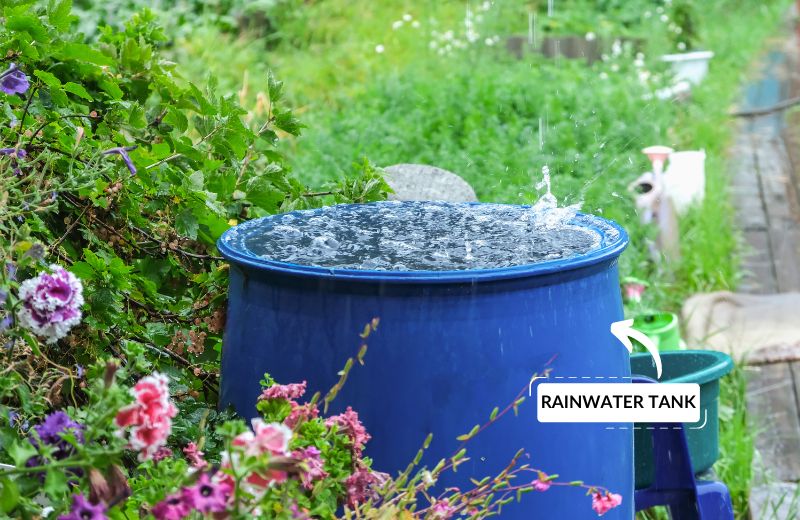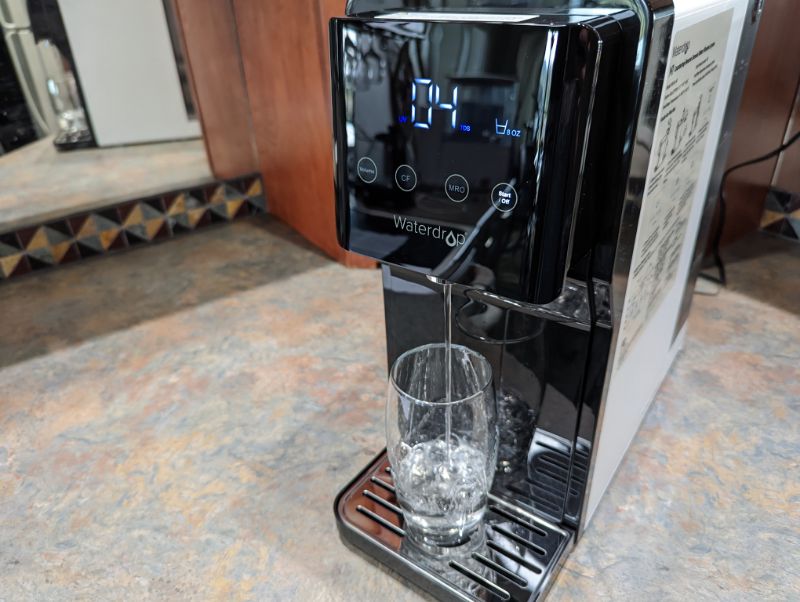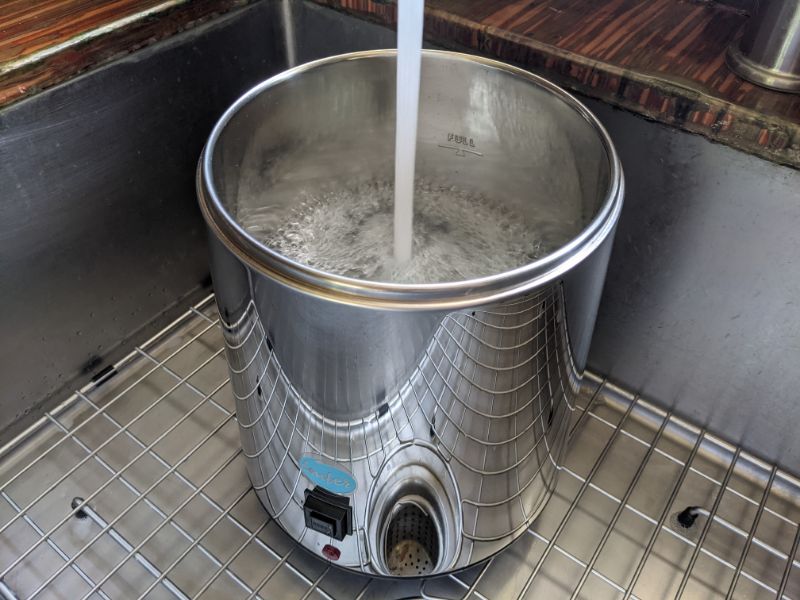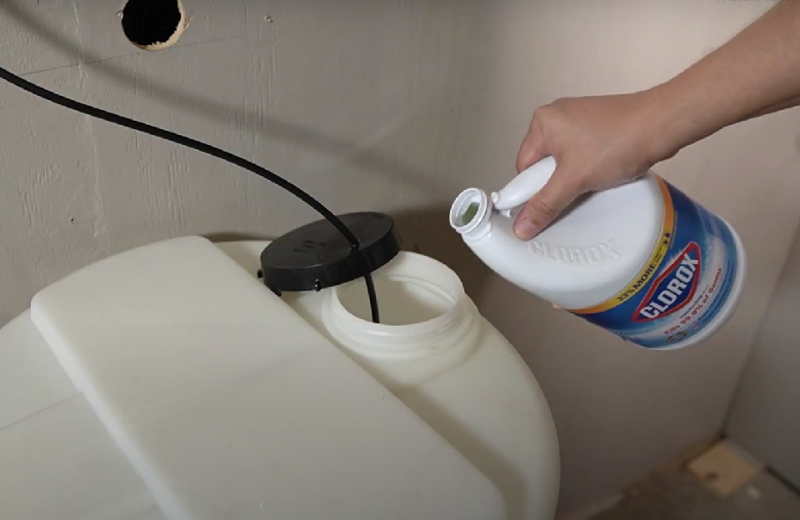Catching rainwater for drinking is a sustainable and cost-effective source of freshwater, helping you to reduce your reliance on traditional water supplies and support environmental conservation.
It’s possible to use rainwater for drinking, cooking, and other indoor uses, but you’ll need to filter the water to make it safe for this purpose.
Here, we’ve shared our expert-recommended methods to filter your harvested rainwater and make it safe to drink.

🚰 Is Rainwater Potable?
Rainwater is relatively pure when it forms in the atmosphere, but its potability can be compromised by contaminants from various sources, such as air pollution, bird droppings, dust, and pollutants (leaves, insects, etc.) from rooftops or catchment surfaces.
Some contaminants in rainwater are particularly dangerous to health:
- A 2022 study recorded the levels of PFOA and PFOS in rainwater and noted that they “often greatly exceed” the Lifetime Drinking Water Health Advisory levels set by the US EPA.
- Another 2019 study noted that air pollution caused acid rain and added heavy metals like lead into the water.
If you don’t properly store and filter your rainwater, these contaminants may render it unsuitable for drinking. So, filtering your rainwater is essential if you want to be certain that you’re not ingesting anything that’s harmful to your health.
💡 Our article on the contaminants commonly found in rainwater provides more information for folks who want it.

Related Article: Where is it illegal to collect rainwater?
So, you’ve got your rainwater harvesting setup ready to go, with a decent-sized water storage tank, and safe, suitable roofing for the rainwater to run down before collecting in the tank.
There are two steps to making rainwater safe to drink: filtration and disinfection.
1️⃣ Step 1: Filtration
Filtering rainwater removes physical suspended or dissolved contaminants in the water, from larger sediment right down to smaller dissolved chemicals and metals.
There are two water filter systems that we recommend for rainwater filtration: reverse osmosis systems and water distillers.
Reverse Osmosis System
If you want to avoid using multiple separate filters to treat your rainwater, the most convenient solution is an all-in-one reverse osmosis system.
Countertop reverse osmosis units are the best option for rainwater filtration. These systems are placed on your kitchen countertop and designed for treating water in batches.
Reverse osmosis is the most thorough filtration process available, so RO systems are an ideal choice if you don’t want to take your chances and want to be reassured that everything is removed from your rainwater for drinking.
How it Works
There are several filter stages in a reverse osmosis system:
- A sediment filter
- An activated carbon filter
- A semi-permeable membrane
- A carbon polishing filter
RO systems are capable of reducing more than 99.99% of total dissolved solids (TDS). Water is forced quickly through these filter stages, and the semi-permeable membrane rejects all contaminants larger than its pore size (typically 0.0001 microns).
The reject contaminants are flushed out of the system with a small amount of wastewater.
The Evidence
- A 2019 comparative analysis of reverse osmosis and UV treatment found that RO reduced TDS by 97.9% and made both surface water and borehole water sources potable.
- A 2023 study evaluated the use of RO systems to provide clean water in developing countries and noted that properly designed RO methods could remove more than 95% of “all potential toxic contaminants” in drinking water.
Best For
Folks who want an all-in-one solution that thoroughly filters rainwater and removes contaminants like bacteria too.

Countertop Water Distiller
A countertop water distillation system is our second recommended solution for purifying rainwater.
Water distillers offer two benefits in one: they remove the majority of dissolved impurities from rainwater, and they also kill microorganisms in the boiling process.
How it Works
Water distillers don’t technically filter rainwater. Instead, they use the process of boiling, evaporation, and condensation to separate the water from its impurities.
Water is heated in the boiling tank until it evaporates. It travels as vapor down a cooling corridor, and condenses into a separate container.
Most impurities are left behind in the boiling chamber because they have higher boiling points than the water.
The Evidence
- The CDC recommends using water distillers to kill protozoa, bacteria, and viruses, and remove common chemical contaminants, including nitrates, arsenic, barium, lead, chromium, and sulfate.
Best For
Anyone who wants to purify small batches of water and doesn’t mind waiting a few hours for the distillation process to take place.

2️⃣ Step 2: Disinfection
Disinfecting rainwater kills or removes microorganisms like bacteria, viruses, or cysts, that could make you sick. According to the CDC, common germs that can contaminate water include:
- E. Coli
- Cryptosporidium
- Salmonella
- Giardia
- Cryptosporidium
There are several different types of water treatment methods that you can use to disinfect your rainwater. Here are the methods that we think are best based on our own experience using them.
UV Purifier
A UV purifier, or UV filter, is typically a final step in a water treatment system.
UV filters can be hooked up to your water line or used in portable water treatment devices, such as water bottles.
How it Works
Ultraviolet light kills microbiological contaminants like bacteria, viruses, and protozoa, by damaging their DNA and preventing them from being able to reproduce.
Note: UV light can only penetrate clear water, so you’ll need to pre-treat turbid rainwater with a 5-micron sediment filter if necessary.
The Evidence
- This study on using UV light for disinfecting well water concluded that UV disinfection removed 100% bacteria from the study water.
- A 2015 study into the effectiveness of a portable UV device found that the ultraviolet light killed 99.99% of bacteria and 99.57% of spores when applied correctly.
Best For
Folks who want an effective way to kill microorganisms in their rainwater without the use of chemicals.
Chemical Disinfection
Chemical disinfection is the process of adding chemicals to rainwater to kill microorganisms and make the water safe to drink.
Several different chemicals can be used for this purpose, including chlorine and chloramine (which, according to the CDC, are the two major disinfectants used by public water systems), as well as ozone, iodine, and chlorine dioxide.
How it Works
You can disinfect rainwater water with chemicals by adding water purification tablets or by using a chemical injection system.
Water purification tablets work by releasing chlorine or iodine into the water, which destroys harmful microorganisms.
Chemical injection systems inject a measured amount of the disinfection chemical into the water. The water is then stored for several minutes to allow the chemical to effectively kill all microorganisms, making it safe to drink.
The Evidence
- The use of chlorine, chloramine, and other chemical disinfectants to kill microorganisms in water is endorsed by the CDC and the EPA – the CDC calls chlorine a “highly effective method of disinfection” and the EPA recommends using chlorine for emergency disinfection of water.
- A scientific review of the disinfection of drinking water noted that chlorine has a “highly satisfactory performance as a disinfectant”, but added that the formation of disinfection byproducts is a setback of this method of water treatment.
Best For
Anyone looking for an affordable, effective method of disinfecting water who doesn’t mind using chemicals for the job.

Boiling
Heating water to boiling point is the simplest and most affordable way to disinfect it. We recommend boiling your rainwater if you just want to disinfect smaller batches of water for drinking.
How it Works
Boiling water damages the structural components of microorganisms, effectively killing or deactivating them.
This method targets most disease-causing germs, including bacteria, viruses, and parasites.
To ensure you kill all microorganisms, bring the water to a rolling boil for 1 minute, then wait for it to cool in a clean, enclosed container before drinking.
The Evidence
- The CDC recommends boiling as the first point of call for making water safe to drink in an emergency.
- A 2008 study on the effectiveness of boiling water in India concluded that boiling the water reduced mean fecal coliforms by 99%.
Best For
People looking for the most affordable solution for killing microorganisms in small batches of rainwater.
Related Article: 18 top Methods for Off Grid Water Filtration and Purification
❔ FAQ
Can you drink rainwater straight from the sky?
No, we don’t recommend drinking rainwater straight from the sky because it’s likely to contain pollutants from the atmosphere, including heavy metals and PFAS (forever chemicals). It’s best to filter rainwater to remove these contaminants and make it safe for consumption before you drink it.
What’s the best way to purify rainwater?
The best way to purify rainwater is to filter it through a reverse osmosis system because it thoroughly removes microorganisms, chemicals, metals, and more, ensuring all the possible contaminants in the water are targeted.
How do you filter rainwater in the wild?
You can filter rainwater in the wild by making an outdoor water distillation system. Dig a hole, then place a container (like an empty coffee can) in the hole and stuff damp green plants around the outside of the can. Place plastic wrap over the hole, then place a small pebble in the middle of the wrap to make a dip. As the sun heats the hole, the moisture from the plants will rise, then condense as it hits the underside of the plastic wrap and drip into the container.
How do you purify water from a rain barrel?
The best way to purify water from a rain barrel is to boil the water or treat it with UV purification to kill bacteria and viruses, then run the water through a countertop reverse osmosis system to remove physical contaminants.
Is it safe to drink filtered rainwater?
Yes, it’s safe to drink filtered rainwater, as long as your rainwater filtration system effectively removes all the contaminants in your water to safe trace levels. If you plan to use rainwater as drinking water, we recommend treating it with a reverse osmosis system or a water distiller, which will eliminate nearly everything that could be in the water.
